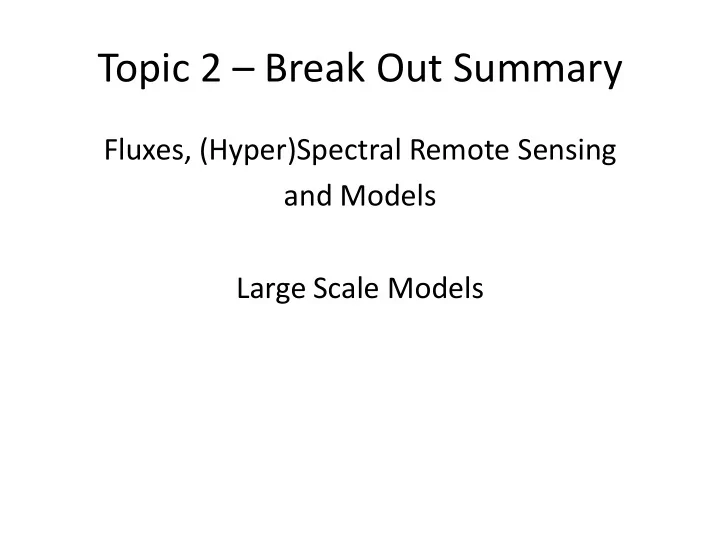

Topic 2 – Break Out Summary Fluxes, (Hyper)Spectral Remote Sensing and Models Large Scale Models
Variance, Uncertainty, & Data Products • Focused on three main topics – Disturbance • Variability arising from ecosystem and human causes – Interannual variability and anomalies • Variability arising from – Uncertainty • Characterization and quantification of errors – Data • What are we missing
Disturbance • Disturbance not well represented in models – Define disturbance as natural component of ecosystems instead of stochastic events – Networks, and remote sensing do not capture longer time scale processes (e.g., processes with 30-50 year return periods) – Need flux tower chronosequences in much larger set ecosystem types – Character/severity of disturbance matters • Much effort in remote sensing towards developing data sets – Fire, insect outbreaks – lots of disagreement across products • Mismatch between what remote sensing can/is providing and what models need • To most effectively link carbon/water consequences of disturbances fluxnet/modeling community needs to define and communicate needs to remote sensing community
Interannual Variation and Anomalies • Interannual variability is hard to capture – Low variance hard to explain • Opportunity to evaluate capacity of models and remote sensing to capture dynamics by focusing on big events/anomalies – Low hanging fruit to help understand what we can and cannot detect and model • Interannual variability/Event-based analysis – Hydrologic anomaly in 2011; European heat wave 2003/2010; Amazonian droughts – Need better information/understanding of drivers, particularly lagged or cumulative effects • Remote sensing of phenological anomalies and changes in seasonality – Exploit information at site level from webcams (Andrew, Lisa)
Uncertainty (in models and data) • Characterization of uncertainty is difficult – Multiple sources of error propagate through model results • Structural error, calibration error, forcing error, representation error (sampling uncertainty) – Enting et al. • Errors in met drivers and remote sensing inputs used for large scale models need more attention • Gaps in sampling – Geography matters (but what can you do about it?) – How can we think about more effective sampling • Biogeographic stratification; clustering of remote sensing/ecoregions, etc • Stratification based on spatio-temporal variation in model outputs • Need community discussion of how to characterize and quantify sources and magnitudes of uncertainty; uncertainty products
Data Products • MODIS subsetting tool at ORNL DAAC provides model to apply other remote sensing data sets at fluxnet sites – One stop shopping is good (DAAC, NEX) • Preliminary wish-list includes – Field measured ecophysiological variables used by models (e.g., V max ) – Medium spatial resolution (10-50 m) maps of model PFTs at fluxnet sites – Landsat archive (time series in support of for e.g., disturbance histories) – Hi-Res Data (<1m) for upscaling (Quickbird, etc) – LIDAR: DESDynI is on hold, but still opportunies from airborne – Hyperspectral (AVIRIS,Hyperion) • Need to lower barriers to access – Probably many others • Remotely sensed PAR
Recommend
More recommend